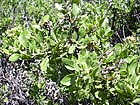Note: This is a project under development. The articles on this wiki are just being initiated and broadly incomplete. You can Help creating new pages.
Pluchea indica
Indian sage is an evergreen, slender, erect, much-branched shrub, growing 1 - 3 metres tall. A popular herbal remedy within its native range, it is gathered from the wild and also traded locally, especially for its use as a diuretic. The plant also provides edible leaves, and is cultivated in gardens as a hedge.
Contents
[hide]- 1 Uses
- 2 Parts Used
- 3 Chemical Composition
- 4 Common names
- 5 Properties
- 6 Habit
- 7 Identification
- 8 List of Ayurvedic medicine in which the herb is used
- 9 Where to get the saplings
- 10 Mode of Propagation
- 11 How to plant/cultivate
- 12 Commonly seen growing in areas
- 13 Photo Gallery
- 14 References
- 15 External Links
Uses
Fever, Lumbago, Asthma, Other pulmonary problems, Colds, Skin diseases, Haemorrhoids, Dysentery, Leucorrhoea.[1]
Parts Used
Young leaves, Shoots, Inflorescences.
Chemical Composition
It contains twelve compounds were identified as multiflorenol, valenc, hydroxy, glucoside, tetrahydroxy-flavone, glucoside, trihydroxyflavone, glucoside, tetrahydroxy-flavone, mannopyranoside, epipinoresinol, pinoresinol etc.[2]
Common names
| Language | Common name |
|---|---|
| Kannada | |
| Hindi | |
| Malayalam | |
| Tamil | |
| Telugu | |
| Marathi | |
| Gujarathi | |
| Punjabi | |
| Kashmiri | |
| Sanskrit | |
| English |
Properties
Reference: Dravya - Substance, Rasa - Taste, Guna - Qualities, Veerya - Potency, Vipaka - Post-digesion effect, Karma - Pharmacological activity, Prabhava - Therepeutics.
Dravya
Rasa
Guna
Veerya
Vipaka
Karma
Prabhava
Habit
Identification
Leaf
| Kind | Shape | Feature |
|---|---|---|
Flower
| Type | Size | Color and composition | Stamen | More information |
|---|---|---|---|---|
| {{{5}}} |
Fruit
| Type | Size | Mass | Appearance | Seeds | More information |
|---|---|---|---|---|---|
Other features
List of Ayurvedic medicine in which the herb is used
Where to get the saplings
Mode of Propagation
How to plant/cultivate
A plant of the lowland tropics. Grows best on fertile soils.[4]
Commonly seen growing in areas
Along the sea shore, Tidal streams, On swamps, On clayish soil.
Photo Gallery
References
- Jump up ↑ Indian Medicinal Plants by C.P.Khare
- Jump up ↑ Chemical constituents
- Jump up ↑ [Morphology]
- Jump up ↑ Cultivation
External Links
- Ayurvedic Herbs known to be helpful to treat Fever
- Ayurvedic Herbs known to be helpful to treat Lumbago
- Ayurvedic Herbs known to be helpful to treat Asthma
- Ayurvedic Herbs known to be helpful to treat Other pulmonary problems
- Ayurvedic Herbs known to be helpful to treat Colds
- Ayurvedic Herbs known to be helpful to treat Skin diseases
- Ayurvedic Herbs known to be helpful to treat Haemorrhoids
- Ayurvedic Herbs known to be helpful to treat Dysentery
- Ayurvedic Herbs known to be helpful to treat Leucorrhoea
- Herbs with Young leaves used in medicine
- Herbs with Shoots used in medicine
- Herbs with Inflorescences used in medicine
- Habit - Evergreen perennial
- Index of Plants which can be propagated by Seeds
- Index of Plants which can be propagated by Cuttings
- Herbs that are commonly seen in the region of Along the sea shore
- Herbs that are commonly seen in the region of Tidal streams
- Herbs that are commonly seen in the region of On swamps
- Herbs that are commonly seen in the region of On clayish soil
- Herbs
- Pages without herbs images






